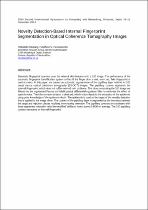 ResearchSpace
ResearchSpace
Novelty detection-based internal fingerprint segmentation in optical coherence tomography images
JavaScript is disabled for your browser. Some features of this site may not work without it.
- ResearchSpace
- →
- Research Publications/Outputs
- →
- Conference Publications
- →
- View Item
| dc.contributor.author |
Khutlang, Rethabile

|
|
| dc.contributor.author |
Nelwamondo, Fulufhelo V

|
|
| dc.date.accessioned | 2015-08-19T10:54:35Z | |
| dc.date.available | 2015-08-19T10:54:35Z | |
| dc.date.issued | 2014-12 | |
| dc.identifier.citation | Khutlang, R and Nelwamondo, F.V. 2014. Novelty detection-based internal fingerprint segmentation in optical coherence tomography images. In: 2014 Second International Symposium on Computing and Networking, Shizouka, Japan 10-12 December 2014 | en_US |
| dc.identifier.uri | http://ieeexplore.ieee.org/xpl/freeabs_all.jsp?arnumber=7052245&abstractAccess=no&userType=inst | |
| dc.identifier.uri | http://hdl.handle.net/10204/8064 | |
| dc.description | 2014 Second International Symposium on Computing and Networking, Shizouka, Japan 10-12 December 2014. Due to copyright restrictions, the attached PDF file only contains the abstract of the full text item. For access to the full text item, please consult the publisher's website | en_US |
| dc.description.abstract | Biometric fingerprint scanners scan the external skin features onto a 2-D image. The performance of the automatic fingerprint identification system suffers if the finger skin is wet, worn out, fake fingerprint is used et cetera. In this paper, we present an automatic segmentation of the papillary layer method, in 3-D swept source optical coherence tomography (SS-OCT) images. The papillary contour represents the internal fingerprint, which does not suffer external skin problems. The slices composing the 3-D image are filtered by the regularized Perona and Malik partial differential equations filter to minimize the effect of speckle noise. Then the corneum stratum is detected, which in turn leads to the extraction of the epidermis using prior knowledge of the epidermis depth. The epidermis is used as the target of the novelty detection that is applied to the image slices. The contour of the papillary layer is segmented as the boundary between the target and rejection classes resulting from novelty detection. The papillary contours are consistent with those segmented manually, with the modified Williams index above 0.9400 on average. The 3-D papillary contour represents an internal fingerprint. | en_US |
| dc.language.iso | en | en_US |
| dc.publisher | IEEE | en_US |
| dc.relation.ispartofseries | Workflow;14844 | |
| dc.subject | Biometrics | en_US |
| dc.subject | Internal fingerprints | en_US |
| dc.subject | Novelty detection | en_US |
| dc.subject | Segmentation | en_US |
| dc.subject | Optical coherence tomography | en_US |
| dc.subject | OCT | en_US |
| dc.title | Novelty detection-based internal fingerprint segmentation in optical coherence tomography images | en_US |
| dc.type | Conference Presentation | en_US |
| dc.identifier.apacitation | Khutlang, R., & Nelwamondo, F. V. (2014). Novelty detection-based internal fingerprint segmentation in optical coherence tomography images. IEEE. http://hdl.handle.net/10204/8064 | en_ZA |
| dc.identifier.chicagocitation | Khutlang, Rethabile, and Fulufhelo V Nelwamondo. "Novelty detection-based internal fingerprint segmentation in optical coherence tomography images." (2014): http://hdl.handle.net/10204/8064 | en_ZA |
| dc.identifier.vancouvercitation | Khutlang R, Nelwamondo FV, Novelty detection-based internal fingerprint segmentation in optical coherence tomography images; IEEE; 2014. http://hdl.handle.net/10204/8064 . | en_ZA |
| dc.identifier.ris | TY - Conference Presentation AU - Khutlang, Rethabile AU - Nelwamondo, Fulufhelo V AB - Biometric fingerprint scanners scan the external skin features onto a 2-D image. The performance of the automatic fingerprint identification system suffers if the finger skin is wet, worn out, fake fingerprint is used et cetera. In this paper, we present an automatic segmentation of the papillary layer method, in 3-D swept source optical coherence tomography (SS-OCT) images. The papillary contour represents the internal fingerprint, which does not suffer external skin problems. The slices composing the 3-D image are filtered by the regularized Perona and Malik partial differential equations filter to minimize the effect of speckle noise. Then the corneum stratum is detected, which in turn leads to the extraction of the epidermis using prior knowledge of the epidermis depth. The epidermis is used as the target of the novelty detection that is applied to the image slices. The contour of the papillary layer is segmented as the boundary between the target and rejection classes resulting from novelty detection. The papillary contours are consistent with those segmented manually, with the modified Williams index above 0.9400 on average. The 3-D papillary contour represents an internal fingerprint. DA - 2014-12 DB - ResearchSpace DP - CSIR KW - Biometrics KW - Internal fingerprints KW - Novelty detection KW - Segmentation KW - Optical coherence tomography KW - OCT LK - https://researchspace.csir.co.za PY - 2014 T1 - Novelty detection-based internal fingerprint segmentation in optical coherence tomography images TI - Novelty detection-based internal fingerprint segmentation in optical coherence tomography images UR - http://hdl.handle.net/10204/8064 ER - | en_ZA |





